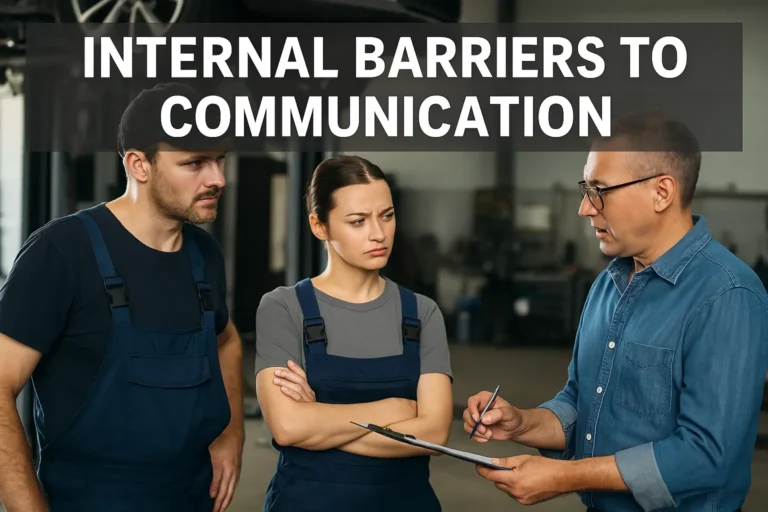Attitudinal Barriers to Communication[Hidden Reasons]
Attitudinal barriers to communication are some of the most common yet overlooked obstacles in both personal and professional settings. These barriers stem from people’s feelings, beliefs, assumptions, or mindsets, which can prevent open and honest dialogue. When attitudes such as prejudice, mistrust, resistance to change, or a lack of interest influence how we interact, communication often breaks down.
What Are Attitudinal Barriers to Communication?
Attitudinal barriers to communication are mental walls that affect how we share and receive messages. These blocks grow from our mindsets, including biases, prejudices, fears, and habits. They often show up as defensiveness, lack of empathy, or reluctance to accept feedback. While other barriers, such as physical noise or language, are external, attitudinal barriers start inside us.
These barriers are rarely intentional. Most of the time, they happen unconsciously. Implicit bias—a kind of automatic mental shortcut—can color how we view others without us even knowing. For example, confirmation bias makes people pay attention only to messages that match their beliefs, shutting out anything new. A lack of psychological safety in a team can also push people to keep quiet, afraid their ideas will be dismissed.
How Do Attitudinal Barriers Affect Communication?
Attitudinal barriers act like filters. Every message is colored by the sender’s and receiver’s feelings, beliefs, and attitudes. A defensive listener might misinterpret feedback as criticism. Someone with a fixed mindset may shut out new ideas before even hearing them. The result? Messages are misunderstood, ignored, or changed entirely.
These barriers can show up in many ways:
- Defensiveness: People reject feedback or get upset when challenged.
- Arrogance: Some believe they know better and dismiss others’ opinions.
- Prejudice and stereotypes: Bias about race, gender, age, or background blocks real understanding.
- Resistance to change: Many stick to “the way we’ve always done it” and avoid new ideas.
- Power dynamics: Leaders or managers might dominate conversations, leaving others silent.
Workplaces that ignore these issues can see high turnover, low morale, and constant misunderstandings. In schools, attitudinal barriers to communication can make students feel unwelcome or unheard, holding back learning.
Recognizing Common Attitudinal Barriers
Knowing what to look for is the first step to overcoming these blocks. Here are key types of attitudinal barriers to communication, with examples you might recognize:
Lack of Empathy
Empathy means understanding and sharing someone else’s feelings. When it’s missing, people feel ignored or invalidated. A teacher who refuses to listen to a struggling student’s explanation, or a manager who doesn’t care about an employee’s stress, both create walls.
Closed-mindedness
Being unwilling to consider new ideas limits growth. A colleague who dismisses suggestions out of hand, or a leader who always says, “We tried that before,” can shut down creativity. Fixed mindsets keep teams stuck.
Implicit and Confirmation Bias
Sometimes, we accept only the information that matches what we already believe. Confirmation bias makes us filter out opinions that don’t fit our worldview, while implicit bias can make us trust some voices and ignore others without realizing it.
Defensive Attitudes
If someone feels threatened or judged, they may react with anger or silence. This blocks honest feedback and problem-solving. Defensive attitudes often show up as interrupting, changing the subject, or outright denial.
Power and Hierarchical Barriers
When leaders dominate discussions, others may feel their input is not valued. Status barriers can make junior staff or students hesitant to share concerns, leading to silence or half-truths.
Ethnocentrism
Believing one’s own culture is superior creates distance. It can show up as judgmental remarks, refusal to consider other traditions, or ignoring cultural differences in communication.
Judgmental Attitudes
Quickly forming opinions without listening fully stops open exchange. Teachers who assume certain students won’t succeed, or managers who label staff as “difficult,” can shut down communication before it starts.
How Organizational Culture and Leadership Shape Attitudes
Organizational culture is the set of shared values and expectations that shapes behavior. When the culture rewards openness, feedback, and respect, attitudinal barriers are less likely to take root. Leaders play a key role—they set the tone by modeling humility, listening, and curiosity.
Teams with high psychological safety—where people feel safe to speak up—are more likely to catch and address attitudinal barriers early. According to MindTools, organizations that regularly measure employee attitudes with surveys and feedback see better results in communication and teamwork.
How Attitudinal Barriers Overlap with Other Obstacles
Attitudinal barriers to communication don’t exist alone. They often combine with language, cultural, and status barriers to make things even harder. For example, someone who feels uncomfortable with another culture may not ask questions, missing important information. Likewise, an employee afraid to speak up due to hierarchy might also struggle with unclear instructions (a language barrier).
When multiple barriers pile up, communication breaks down faster. This is why organizations need a broad approach—addressing attitudes, channels, and access all at once.
Real-World Case Study
At a global tech company, managers noticed junior engineers rarely contributed new ideas in meetings. An internal survey found many felt their suggestions were dismissed by more senior staff, who often relied on their experience and shut down debate.
To fix this, the company introduced anonymous idea boards, allowing anyone to share feedback without fear of judgment. Managers were trained in active listening, and meetings included set times for junior team members to speak. Over the next year, employee surveys showed a 40% increase in satisfaction with communication and a rise in successful new projects. This simple change helped break down attitudinal barriers to communication and built a culture of trust.
Strategies to Overcome Attitudinal Barriers to Communication
Breaking down attitudinal barriers to communication is possible. Here are proven ways to do it:
Build Self-Awareness
Take time to reflect on your own attitudes and beliefs. Ask yourself, “Am I open to new ideas? Do I dismiss opinions that don’t match mine?” Honest self-assessment helps uncover unconscious bias.
Encourage Feedback
Open communication relies on feedback. Ask colleagues or students how your behavior affects them. Regular surveys or 360-degree feedback help teams spot issues early.
Practice Empathy and Active Listening
Empathy is a skill you can learn. Try to see the situation from the other person’s point of view. Active listening—giving your full attention, nodding, and repeating back key points—shows respect and reduces defensiveness.
Support Psychological Safety
Create environments where people feel safe sharing ideas and concerns without fear of punishment. Leaders should thank employees for honest feedback, even if it’s critical.
Promote a Growth Mindset
Teams that welcome learning and change are less likely to get stuck. Encourage curiosity, reward people for trying new things, and model openness yourself.
Address Power Dynamics
Leaders should make space for everyone to speak. Rotate meeting facilitators, or use anonymous suggestion tools to balance status gaps.
Foster Cultural Competence
Training in cultural awareness and communication helps people understand and respect differences. This is especially important in diverse workplaces and classrooms. Harvard Business Review’s article shows that cultural competence can prevent conflicts and boost teamwork.
Set Clear Expectations and Conflict Resolution Channels
When expectations are clear and everyone knows how to resolve disagreements, judgmental or defensive attitudes are less likely to take over.
Strategies and How They Help
| Strategy | How It Helps |
|---|---|
| Build Self-Awareness | Uncovers bias, opens mind to new perspectives |
| Encourage Feedback | Surfaces issues early, builds trust |
| Empathy & Active Listening | Reduces conflict, fosters understanding |
| Psychological Safety | Makes all voices welcome |
| Growth Mindset | Keeps teams adaptable and open to change |
| Address Power Dynamics | Gives everyone a chance to contribute |
| Cultural Competence | Bridges gaps, reduces misunderstandings |
| Clear Expectations | Prevents confusion and blame |
Can Training and Education Overcome Attitudinal Barriers?
Training and education can help, but they must be ongoing and meaningful. Simple awareness workshops are not enough. Instead, organizations should provide interactive training that encourages personal reflection and real-world practice. Voluntary participation and leadership support make these programs more effective.
Psychological and behavioral approaches—like mindfulness, cognitive reframing, and coaching—can help people recognize and change automatic negative thoughts. Regular feedback, open discussion, and clear consequences for disrespectful attitudes reinforce these changes.
Measuring progress with surveys, regular check-ins, or focus groups lets leaders track improvement and adjust their approach as needed.
Effects of Attitudinal Barriers in the Workplace
Ignoring attitudinal barriers to communication leads to:
- Lower productivity
- Reduced trust and teamwork
- Higher turnover and burnout
- More frequent conflict and misunderstanding
- Missed business or learning opportunities
A single negative attitude can spread quickly, harming morale and performance across teams.
Conclusion
Attitudinal barriers to communication are among the most powerful obstacles in any organization, classroom, or relationship. They shape the way we listen, speak, and interpret every message. The good news? With effort and the right tools, anyone can identify and overcome these barriers. Build self-awareness, seek feedback, and model empathy. Support psychological safety, address power differences, and reward curiosity. Breaking down attitudinal barriers to communication opens the door to honest conversations, trust, and lasting success.
Want more ways to improve your team’s communication? Visit our [communication skills resource center] for practical tips and real-world solutions.
FAQs
Start with honest self-awareness. Recognize your own biases and ask for feedback from others.






